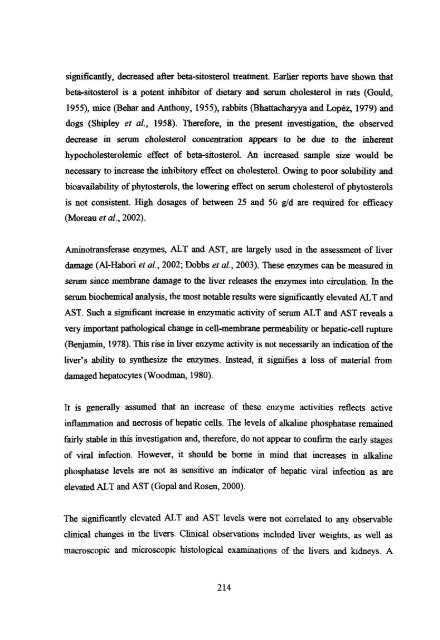ANTI-NUTRITIONAL CONSTITUENT OF COLOCASIA ESCULENTA ...
ANTI-NUTRITIONAL CONSTITUENT OF COLOCASIA ESCULENTA ...
ANTI-NUTRITIONAL CONSTITUENT OF COLOCASIA ESCULENTA ...
You also want an ePaper? Increase the reach of your titles
YUMPU automatically turns print PDFs into web optimized ePapers that Google loves.
significantly, decreased after beta-sitosterol treatment. Earlier reports have shown that<br />
beta-sitosterol is a potent inhibitor of dietary and serum cholesterol in rats (Gould,<br />
1955), mice (Behar and Anthony, 1955), rabbits (Bhattacharyya and Lopez, 1979) and<br />
dogs (Shipley et al., 1958). Therefore, in the present investigation, the observed<br />
decrease in sennn cholesterol concentration appears to be due to the inherent<br />
hypocholesterolemic effect of beta-sitosterol. An increased sample size would be<br />
necessary to increase the inhibitory effect on cholesterol. Owing to poor solubility and<br />
bioavailability of phytosterols, the lowering effect on sennn cholesterol ofphytosterols<br />
is not consistent. High dosages of between 25 and 50 gld are required for efficacy<br />
(Moreau et al., 2002).<br />
Aminotransferase enzymes, ALT and AST, are largely used in the assessment of liver<br />
damage (Al-Habori et aI., 2002; Dobbs et al., 2003). These enzymes can be measured in<br />
sennn since membrane damage to the liver releases the enzymes into circulation. In the<br />
sennn biochemical analysis, the most notable results were significantly elevated ALT and<br />
AST. Such a significant increase in enzymatic activity of sennn ALT and AST reveals a<br />
very important pathological change in cell-membrane permeability or hepatic-cell rupture<br />
(Benjamin, 1978). This rise in liver enzyme activity is not necessarily an indication ofthe<br />
liver's ability to synthesize the enzymes. Instead, it signifies a loss of material from<br />
damaged hepatocytes (Woodman, 1980).<br />
It is generally assumed that an increase of these enzyme activities reflects active<br />
inflammation and necrosis of hepatic cells. The levels of alkaline phosphatase remained<br />
fairly stable in this investigation and, therefore, do not appear to confirm the early stages<br />
of viral infection. However, it should be borne in mind that increases in alkaline<br />
phosphatase levels are not as sensitive an indicator of hepatic viral infection as are<br />
elevated ALT and AST (Gopal and Rosen, 2000).<br />
The significantly elevated ALT and AST levels were not correlated to any observable<br />
clinical changes in the livers. Clinical observations included liver weights, as well as<br />
macroscopic and microscopic histological examinations of the livers and kidneys. A<br />
214
















